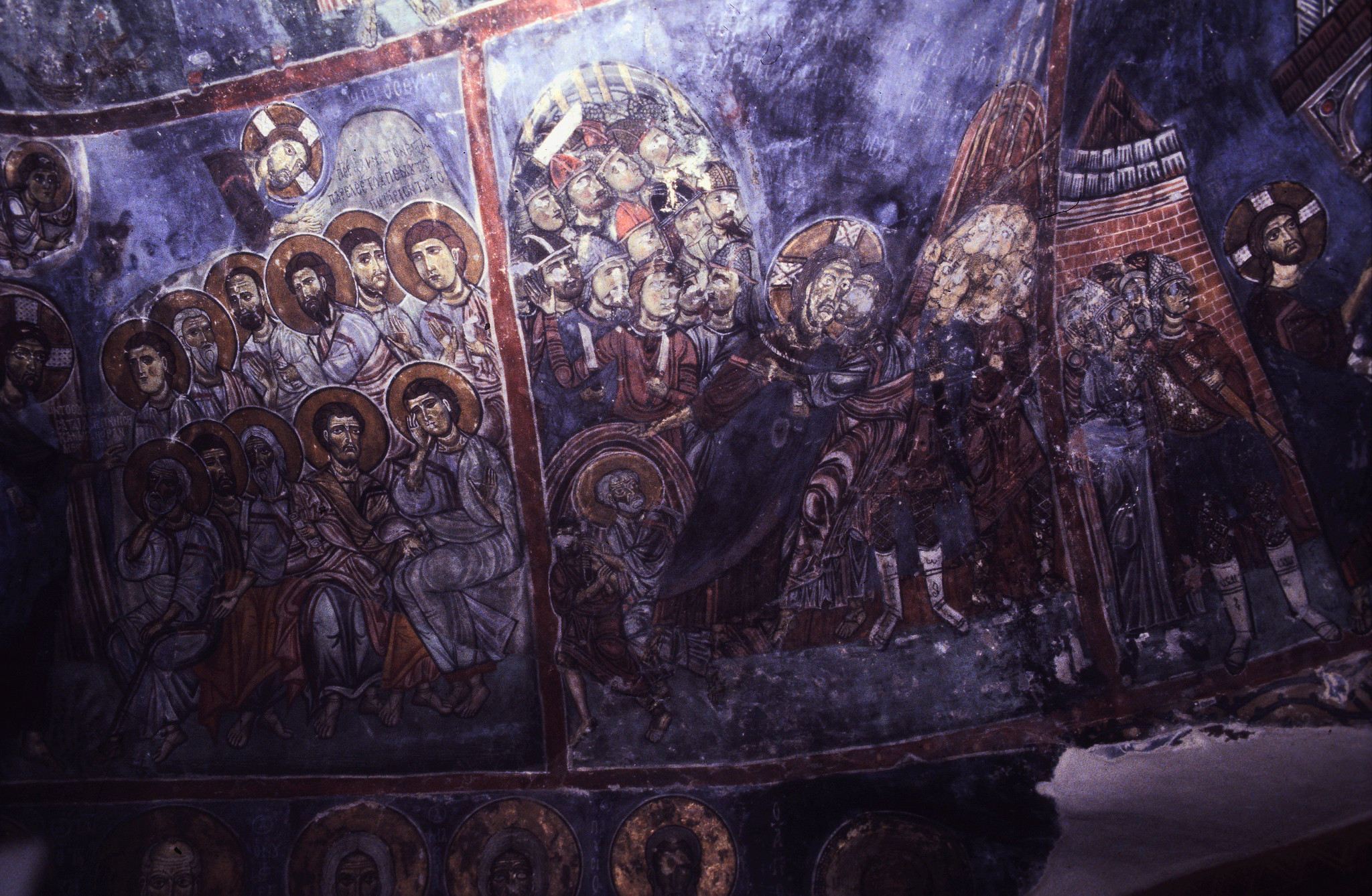Amazon Prime Student 6-month Trial

Try Amazon Audible Premium Plus and Get Up to Two Free Audiobooks
Illustration of Byzantine Soldiers in
'Jesus Betrayed by Judas' and 'Christ before Pilate'
Byzantine Frescoes in the Enkleistra (cave church) of St. Neophytos, Paphos, Cyprus, 1182-1196AD

Photo by Rüdiger Stehn, August 1982
A hermitage in caves dug into a cliff face by St. Neophytos. Now part of a monastery complex.
Referenced in Raffaele d'Amato The Betrayal: Military Iconography and Archaeology In The Byzantine Paintings Of The 11th-15th C. AD Representing The Arrest Of Our Lord
A further example comes from the Church of Saint Neophitos, in the Paphos district of Cyprus, dated to about 1196 AD or the early 13th c.44
Two groups of warriors surround the protagonists from left and right. The soldiers carry knives, a sword, a flail, spears, pole-axes and torches.
The Chiliarchos carries the sword and the flail and is dressed with a short chiton, and a chlamys (military cloak),
eastern αναξυριδεs (trousers) and white toubia (boots).
The heads are covered by chain-mail coifs with nape protection, brown or red helmets supplemented with a conical plate or a metal frame in grey, ochre or red background.45
Most of the helmets are reinforced with scales and with attached protective aventails (neck protections, peritrachelia).46
Interestingly, the represented sword is an infantry sabre (spathion zostikion?).47
44 Babuin 2009, figs. 108-109; Stylianou, Stylianou 1992, pp. 573ff., n. 18, Pl. 318; Stylianou calculated in 1985 that in Cyprus’s churches there were about 14 wall-paintings of the Betrayal, but the number should have been superior.
45 Haldon 1975, p. 26.
46 D’Amato 2010, p. 33.
47 Praecepta Militaria (I, 24ff.), p. 14.
Some Roman warriors wear long beards that in the fresco are red and fair; they thus have Anglo-Saxon and Nordic attire. In Byzantium the members of the Varangian Guard were famous as men with red hair and beards, "as tall as date palms;" they were also said to drink too much. The description of the Varangians who impressed the Romans of the East
with their huge size, blonde and red hair, beards and moustaches, is well remembered in the Northern sources.48
48 "He was striking of countenance and fair of feature, he had the finest eyes of any man, and was light of hue. He had a great deal of hair as fair as silk, falling in curls"; "This man had yellow hair, waving down over his shoulders; he was fair of hue" "Next there sat two men like each other to look upon, and might have been of middle age; most brisk they looked, red of hair, freckled of face, yet goodly to behold." (Laxdale Saga, cap. 28.63 - Muriel 1889, pp. 87, 220). It is true that red beard often equals evil character in medieval art, but guardsmen with red beards are also represented like bodyguards of Saint Emperors or Kings in the frescoes of the councils, or escorting Joshua, like in the Church of Blachernae in Arta, Epeiros, or in the Church of Saint Sofia in Kiev, respectively 13th and 12th centuries, s, D’Amato, 2010, p.13, and D’Amato, 2012, pp. 38-39.
Again, they are pictured as armed with axes and knives, so we are again probably in front of the representation of Varangians. The knives show a very similar shape to the late 12th c. battle knives found at Ras, Serbia,49 the axes with an axe-head from Thebes, dated to the 13th c.50 If the fresco was painted under the new Latin rulers of Cyprus rival of the Angels[?] in Constantinople, the use of Imperial Guardsmen as models for "evil" people could be very probable. According to Stylianou they are maybe representations of Crusaders who invaded Cyprus,51 but their full equipment is completely Eastern-Roman.
49 Nicolle 1999, cat. 82 h-i.
50 Various 2002, p. 134, cat. 145.
51 Stylianou, Stylianou 1992, p. 575.
Referenced as figure 231 in The military technology of classical Islam by D Nicolle
231A to 231D. Frescoes, A - Christ before Pilate, B - Crucifixion, C - Road to Calvary, D - The Betrayal, c. 1200 AD, Byzantine, in situ, Hermitage of St. Neophytos, Enkleistra, Cyprus.

Back to Frescoes in the Enkleistra of St. Neophytos, Cyprus, 1182-1196AD



